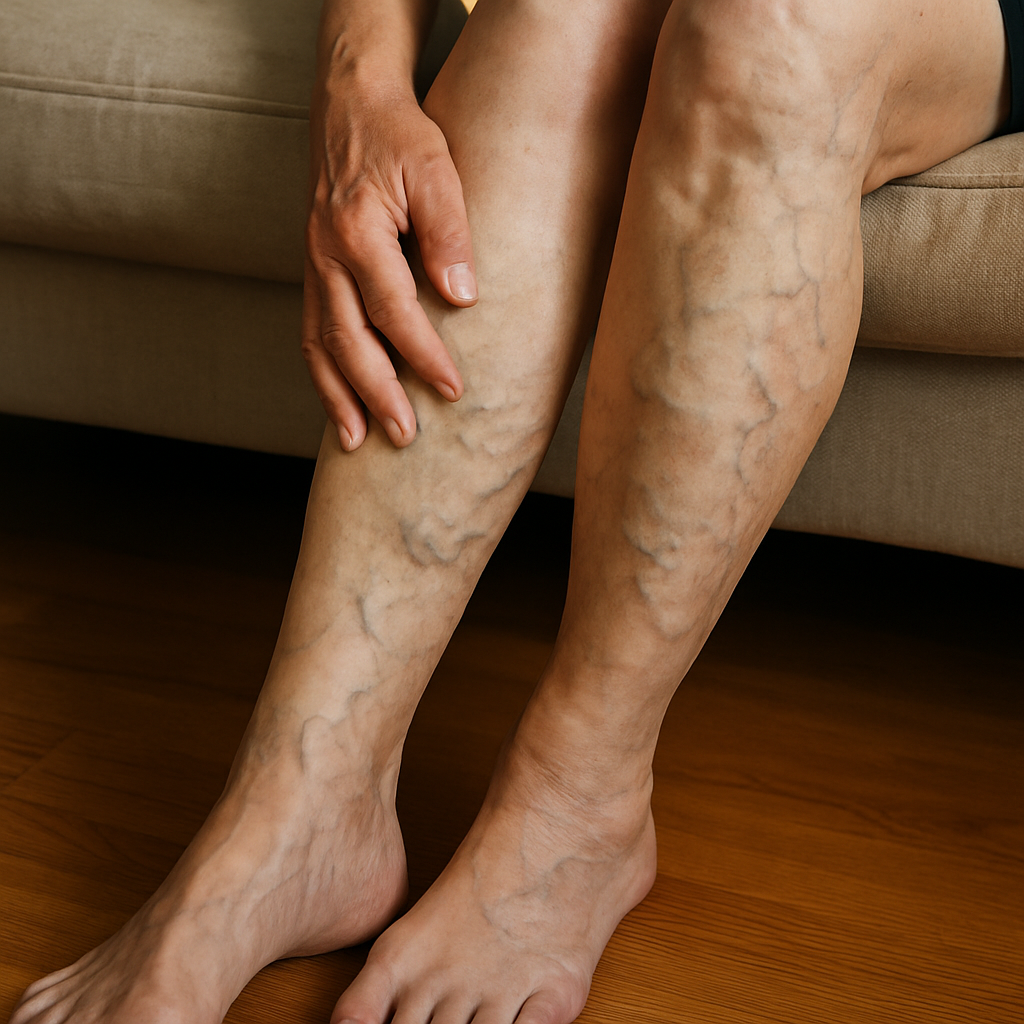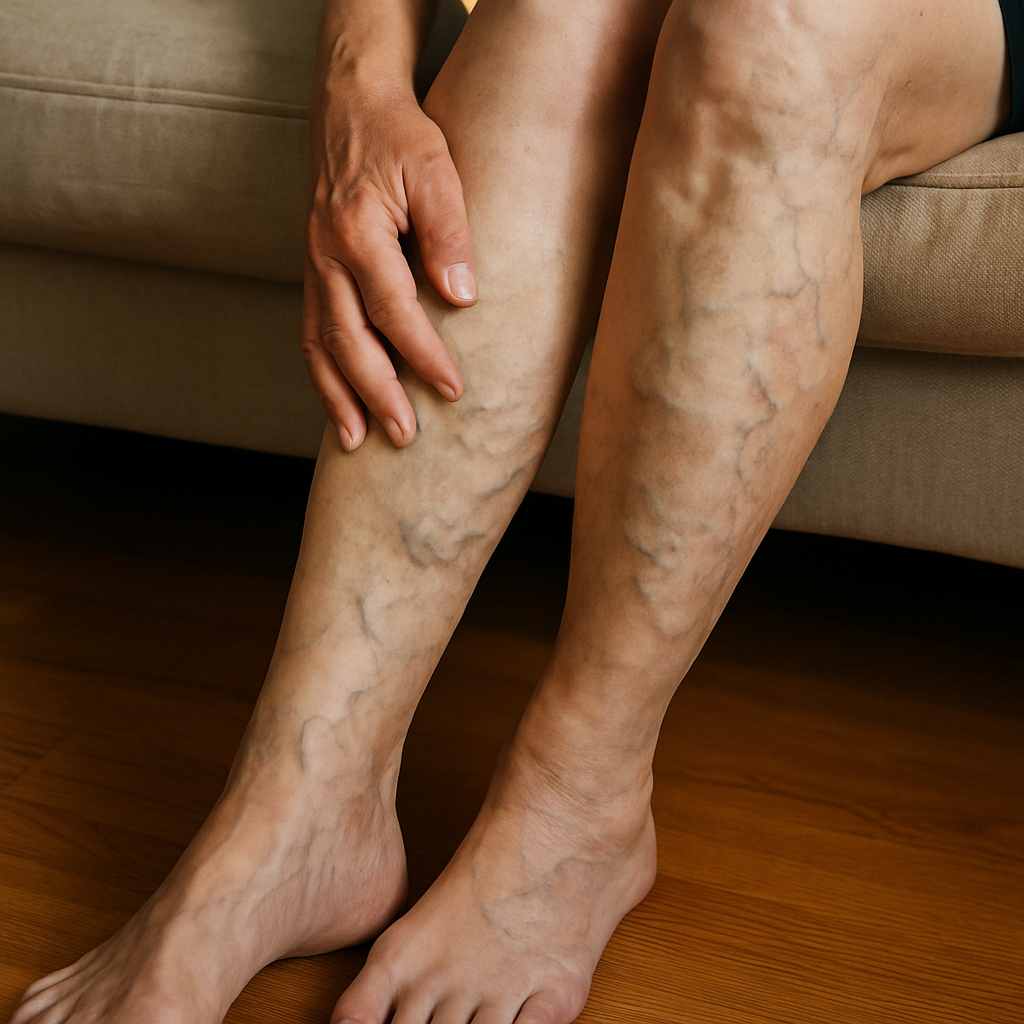Ask Ayurvedic doctor a question and get a consultation online on the problem of your concern in a free or paid mode. More than 2,000 experienced doctors work and wait for your questions on our site and help users to solve their health problems every day.
Shop Now in Our Store
When to Worry About Varicose Veins: Symptoms and Ayurvedic Care

If you've ever noticed twisted, bulging veins on your legs or feet and wondered, “Is this serious?” — you're not alone. Varicose veins are incredibly common, especially as we age, but that doesn't mean they should be ignored. Knowing when to worry about varicose veins can literally save you from complications down the road. Catching early stage varicose veins symptoms and understanding the signs and symptoms of varicose veins can make a huge difference in how manageable they are.
In this guide, we'll break down everything you need to know — from how varicose veins form, to what Ayurveda says about it, and when it's time to stop brushing it off as just “a cosmetic issue.” Whether you're feeling occasional heaviness or seeing visible veins for the first time, understanding the varicose veins symptoms and when to worry about varicose veins in feet is a big first step toward better health. Let’s get into it.
What Are Varicose Veins
Varicose veins are enlarged, twisted veins that most commonly appear in the legs and feet. They occur when the valves inside your veins stop working properly, causing blood to pool instead of flowing smoothly back to the heart. That’s what leads to the telltale bulging or rope-like appearance.
Causes of Varicose Veins from Medical and Ayurvedic Perspectives
From a Western medical standpoint, varicose veins result from weak or damaged vein walls and valves. Factors like genetics, prolonged standing, obesity, and pregnancy are known contributors.
Ayurveda, on the other hand, sees varicose veins as an imbalance in Vata dosha, which governs movement and circulation. Blockages in rakta dhatu (the blood tissue) and poor flow in srotas (the body’s channels) are believed to contribute to the appearance and discomfort of varicose veins.
Risk Factors: Who’s Most Affected and Why
You're more likely to experience varicose veins symptoms in legs if you:
-
Stand or sit for long periods (yup, desk jobs count)
-
Have a family history of varicose veins
-
Are over the age of 40
-
Are pregnant or have been multiple times
-
Are overweight or obese
It’s not just about age or weight though — even active people can develop varicose veins if other risk factors are in play.

Early Stage Varicose Veins Symptoms
Okay, here’s where things get real. The varicose veins early symptoms can be subtle, and many people just chalk them up to being tired. Don’t.
What Differentiates Mild Discomfort from a Medical Concern
You might start with:
-
Achy or heavy feeling in your legs
-
Itching around one or more of your veins
-
Slight swelling in the ankles or lower legs
-
Thin, visible veins under the skin that seem harmless
Sound familiar? These are classic early stage varicose veins symptoms. It’s easy to ignore these signs and symptoms of varicose veins, thinking they’re “just from a long day.” But these early warnings are telling you something’s not quite right — maybe not urgent yet, but definitely not to be shrugged off either.
Many people wait until the pain or swelling gets bad, or worse — until ulcers or skin changes show up — to take it seriously. But honestly, the best time to act is before things spiral into full-on discomfort or complications.

Progression and When to Take Action
Varicose veins don’t just show up overnight in full force. Like most health issues, they start slow and get worse if left unchecked. Understanding the stages of when to worry about varicose veins can help you act early and avoid long-term damage.
Stages of When to Worry About Varicose Veins
Let’s break this down into a few key stages:
Stage 1: Mild Symptoms (aka the Denial Phase)
You notice a dull ache in your legs, maybe after standing too long. There might be visible veins, but they don’t bulge much. This is when most people think, "Eh, not a big deal."
Stage 2: Increased Swelling and Discomfort
Now you're seeing puffiness around your ankles. Your legs feel heavy, and maybe there’s a burning sensation or itchiness. These are no longer just aesthetic issues. You’ve entered the zone of when to worry about varicose veins more seriously.
Stage 3: Skin Changes and Vein Bulging
Your skin might turn darker around the ankles or start to feel leathery. Veins are visibly bulging and uncomfortable. This is also when to worry about varicose veins in feet, especially if you're getting cramps or tightness.
Stage 4: Ulcers and Complications
Open sores or ulcers develop. There’s a real risk of infection. At this point, when to worry about varicose veins treatment isn't even a question — it’s urgent.
Varicose Veins Symptoms That Signal Urgency
Here are red flags that mean it’s time to see a doctor ASAP:
-
Bleeding from varicose veins
-
Sudden pain or swelling in one leg (could mean a blood clot)
-
Skin around the vein becomes red, warm, or tender
-
Ulcers that don’t heal
These symptoms of varicose veins are beyond cosmetic. They could signal deep vein thrombosis or other vascular conditions that need immediate attention. Don’t wait it out — it won't just “go away.”

Ayurvedic Understanding of Varicose Veins
While modern medicine focuses on veins and valves, Ayurveda digs deeper — into the energetic imbalances and flow of life forces.
Imbalance in Vata and Rakta Dhatu
In Ayurvedic terms, varicose veins stem from Vata dosha going out of balance, especially in the rakta dhatu, which governs blood tissue. Vata is responsible for movement, including blood flow. When it's aggravated, it causes dryness, weakness, and instability in the vessels.
Interestingly, this aligns with how we see weak vein walls in allopathy — different language, same issue.
Connection to Poor Circulation and Digestive Fire
Another interesting Ayurvedic view is how poor digestion can actually mess with your circulation. If your Agni (digestive fire) is low, your blood isn't nourished properly. Toxins (ama) build up and block circulation in the srotas, or microchannels. The result? Swelling, inflammation, and yes — varicose veins.
The Role of Srotas (Body Channels) in Vein Health
Your body’s circulation runs through a network of srotas. Think of them like roads. If there's a traffic jam — or worse, a roadblock — things get congested. In Ayurvedic terms, this blockage can be caused by cold, dryness, poor digestion, or toxin build-up. That stagnation shows up in your legs first because, well, gravity doesn’t help.

Ayurvedic Remedies and Lifestyle Changes
The good news? You don’t always need drastic treatments right away. Ayurveda offers powerful, natural tools to improve circulation, reduce inflammation, and support vein health — especially when you're dealing with varicose veins early symptoms.
Herbal Support (e.g. Ashwagandha, Gotu Kola, Guggulu)
Let’s start with some herbs. Ayurveda is big on plant-based support, and these three are top picks:
-
Ashwagandha: Known for strengthening the body and calming Vata. It helps reduce stress-related circulation issues, which weirdly enough, can trigger or worsen varicose veins.
-
Gotu Kola: This little green herb is kind of a superhero for your veins. It improves blood flow, strengthens capillaries, and reduces swelling. Perfect for early stage varicose veins symptoms.
-
Guggulu: A resin used in many Ayurvedic formulas, Guggulu helps detoxify the blood and reduce inflammation — especially when veins are sore, itchy, or painful.
Just don’t self-medicate blindly. Check with an Ayurvedic practitioner for dosages, especially if you're already taking other meds or have underlying issues.
Daily Routines and Leg Elevation Practices
Sometimes, it’s the little things that matter most. Here's what you can start today:
-
Elevate your legs for 10–15 minutes daily. It helps reverse the gravitational pull that worsens vein pressure.
-
Avoid sitting or standing too long. Set timers. Stretch. Walk. Move.
-
Dry brushing in the direction of blood flow can stimulate circulation and lymph drainage. Bonus: it feels kinda great.
And if you love yoga, poses like Viparita Karani (legs-up-the-wall) are gentle, beginner-friendly, and very effective. We’d suggest an infographic here showing 3–4 beginner poses to support vein health and lymphatic drainage.
Diet Tips to Improve Circulation and Reduce Inflammation
Your plate matters — maybe more than you think.
-
Focus on warming, nourishing foods: think soups, cooked veggies, and healthy fats (hello ghee).
-
Avoid heavy, cold, greasy foods — they aggravate Vata and slow digestion.
-
Add spices like turmeric, cumin, ginger, and garlic, which improve circulation and reduce blood stagnation.
-
Drink warm water through the day. Cold drinks can dampen your Agni and mess with detox pathways.
An illustrated comparison between a Vata-pacifying plate and a standard inflammatory Western meal could work well here to help visualize the difference.
Conclusion
Varicose veins might be common, but they aren’t something to ignore. Catching the varicose veins early symptoms gives you a powerful window of opportunity — one where lifestyle tweaks and Ayurvedic care can make a real difference. From herbal remedies and yoga to understanding when to worry about varicose veins, you now have the tools to take proactive care of your legs (and your health).
Start small. Elevate those legs. Add turmeric to your meals. Be aware of varicose veins symptoms in legs, especially when they begin to itch, swell, or ache. And remember — your body is always talking to you. You just gotta learn how to listen.
FAQs
What are the warning signs that varicose veins are getting worse?
Watch for increased swelling, bulging veins, skin discoloration, and any kind of ulcer or sore that won’t heal. These are signs you’ve moved beyond the early stage and should probably not wait it out.
Are early symptoms of varicose veins reversible with lifestyle changes?
In many cases, yes! With proper diet, movement, and herbal support, you can reduce discomfort and possibly prevent further progression. The key is catching it early.
What are the long-term risks of ignoring varicose veins?
Chronic pain, leg ulcers, bleeding, and even blood clots (like DVT) can happen if varicose veins are left untreated. That’s why knowing when to worry about varicose veins is so important.
This article is checked by the current qualified Dr Sujal Patil and can be considered a reliable source of information for users of the site.

